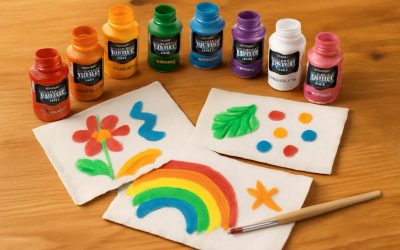
Acrylic fabric paint is a special type of acrylic paint that is specifically designed to be applied to fabrics. It provides a smooth, durable finish and allows for the use of synthetic and other types of fabrics.
Fabric paint can be made in a variety of colors and finishes, ranging from opaque to glittery. These acrylic paints can be purchased in bottles, pens, and sprays. You can also create your own by mixing acrylic-based paint with an acrylic medium.
If you plan on displaying your work, you should purchase a high-quality fabric medium. Most textile mediums require two parts medium to one part paint. However, you don’t need to use a medium for basic, unframed craft projects.
Some people have complained about the oh-so-common bleed-through, but this is usually not a big deal. It may be better to spot-treat your first few washes with your favorite fabric paint to ensure your project’s durability.
There are many ways to seal acrylic paint on fabric, but the best option is to use heat. Heat can be provided by a hair dryer or iron. The heat will lock in the paint and prevent it from peeling and washing off. Depending on the type of material you are painting, you may need to make several layers of paint before you achieve a good finish.
Using the right brush is a must. Make sure your brush is not too rough or your design will become snagging. A small, flat brush works well for this purpose. You can also try a stencil if you like. This will help you cover a larger area of fabric with a single pass of your brush.
When you’re done painting, let the paint dry for at least 24 hours. Next, put the fabric on a hanger. Once the paint has completely dried, remove the barrier board from between the fabrics. For heavier-weight fabrics, you can heat set the paint with an iron.
There are a number of other tips to keep in mind when using acrylic fabric paint. Some things you should keep in mind are how to clean your paint brushes, how to avoid snagging the fibers, and whether or not your fabric is washable. In general, you should not attempt to mix acrylic paint with water or acetone, as they will degrade plastics. Also, be sure to test the paint on a swatch of the same fabric you plan on painting.
Another useful tip is to not use vinegar. Vinegar can dissolve the acrylic paint, altering its structure. Additionally, the vinegar can leave an uneven color saturation. Other additives can make acrylic fabric paint work on a wide range of cloths.
The best way to do this is to buy a quality, opaque acrylic medium. A transparent medium isn’t necessary, but you should try to choose a medium that’s lightweight and won’t be too thick. An opaque medium will ensure a good finish on darker-colored fabrics, while a transparent medium will work best with lighter-colored fabrics.



0 Comments